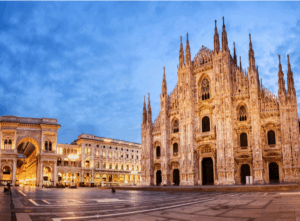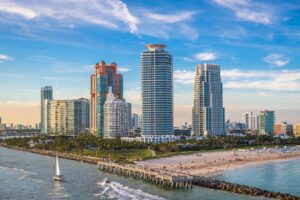The US commercial real estate sector is witnessing a profound transformation that belies the simple narrative of market distress. While traditional metrics show pressure points – with office building delinquencies exceeding 10% in November 2024 – the industry’s response reveals an unprecedented capacity for reinvention. This evolution, driven by necessity but fueled by innovation, is reshaping urban landscapes across America.
The reimagining of office spaces has emerged as a defining trend of this market cycle. CBRE Group’s latest data, showing 73 completed conversion projects in 2024 with another 309 in the pipeline, merely hints at the scale of this transformation. These aren’t merely stopgap measures – they represent a fundamental rethinking of urban space utilization.
In New York, the iconic Flatiron Building’s planned conversion to condominiums symbolizes this shift. Such high-profile transformations are proving that even the most historically significant properties can find new purpose and economic viability through thoughtful redevelopment. This changing perspective on commercial assets reflects an industry-wide recognition that adaptability is essential for long-term sustainability in urban environments.
Urban Revitalization and Success Stories
Mid-sized cities are emerging as laboratories for commercial property innovation. Cleveland’s ambitious conversion programme, encompassing 12% of its office inventory, demonstrates how these urban centers can lead in reimagining commercial spaces. The city’s Public Square project, with its $50 million investment in public amenities, has become a catalyst for surrounding property transformations, creating a virtuous cycle of urban renewal.
Detroit’s Renaissance Center redevelopment represents another watershed moment in commercial property evolution. The conversion of office space into residential units and a hotel in this landmark complex signals that even the most traditionally office-centric structures can be successfully reimagined. These projects are creating new templates for urban revitalization that combine preservation of architectural heritage with modern functionality.
The broader implications of this market transformation extend far beyond real estate metrics. Successful conversions are creating new residential communities in formerly office-dominated districts, supporting local businesses and maintaining urban vitality. This mixed-use approach may prove more resilient to future market shifts than traditional single-use developments.
Investment Strategies and Market Adaptation
The market’s recalibration has created compelling opportunities for strategic investors with vision and patience. Daniel Neidich’s Dune Real Estate Partners, in partnership with TF Cornerstone, exemplifies this trend with their $1 billion commitment to conversion projects. Their approach – targeting properties at adjusted valuations – allows for the creation of amenity-rich residential spaces that would be unfeasible in new construction.
The industry’s response to current challenges demonstrates remarkable sophistication. Property owners are adopting more nuanced approaches to asset management, with some maintaining equity positions in converted properties to gain expertise in this emerging sector. This strategic pivot suggests a longer-term vision for market evolution that goes beyond short-term financial considerations.
Early success stories are providing compelling evidence of market demand for converted spaces. In Washington, D.C., a converted Peace Corps headquarters building achieved 70% occupancy within four months of opening, with rents exceeding initial projections. Such results suggest a robust market for thoughtfully executed conversions that address contemporary living and working preferences.
Government Support and Public-Private Partnerships
Municipal authorities are increasingly recognizing their crucial role in facilitating urban transformation through commercial property conversions. Chicago, Washington, D.C., and Calgary have implemented innovative incentive programmes that demonstrate how public sector support can catalyze private investment. These initiatives go beyond simple tax breaks, creating comprehensive frameworks for sustainable urban renewal.
The success of these public-private partnerships highlights the importance of coordinated approaches to urban development. When municipal governments provide regulatory flexibility, targeted incentives, and infrastructure improvements, private developers can more confidently undertake ambitious conversion projects. This collaborative model is emerging as a blueprint for addressing commercial property challenges nationwide.
Local authorities are also rethinking zoning regulations to facilitate adaptive reuse of commercial buildings. By streamlining approval processes for conversions and providing density bonuses for projects that include affordable housing or public amenities, cities are creating regulatory environments that encourage innovation while ensuring community benefits.
Technical Innovation and Design Solutions
Technical innovation is expanding the universe of conversion candidates beyond the obvious choices. Engineering and architectural firms are developing specialized expertise in overcoming the structural and mechanical challenges inherent in commercial-to-residential conversions. GFP Real Estate’s creative solution at 25 Water Street in Manhattan, implementing light wells to ensure adequate natural illumination, showcases how engineering solutions can overcome traditional conversion barriers.
Sustainable design principles are increasingly integrated into conversion projects, with developers leveraging existing structural elements to reduce embodied carbon while upgrading systems for energy efficiency. This approach aligns with growing tenant and investor preferences for environmentally responsible spaces while often qualifying projects for additional incentives.
Digital modeling and building information management systems are streamlining the conversion process by allowing developers to identify and address potential challenges before construction begins. These technological tools, combined with modular construction techniques, are reducing project timelines and costs while expanding the range of viable conversion candidates.
Economic and Community Impact
The economic impact of successful commercial property conversions extends throughout urban ecosystems. By maintaining building occupancy and introducing new residents to formerly commercial districts, these projects support retail establishments, restaurants, and service providers that might otherwise struggle with reduced office populations. The resulting mixed-use neighborhoods offer improved resilience against sector-specific downturns.
Community engagement has emerged as a critical success factor in conversion projects. Developers who actively collaborate with neighborhood stakeholders to address concerns about density, design, and affordability typically experience smoother approval processes and stronger market reception. This collaborative approach represents a maturation of the development industry’s understanding of urban dynamics.
The introduction of residential populations into formerly commercial areas is creating opportunities for 24-hour districts with improved safety and vitality. Properties that complement conversions with ground-floor retail, public spaces, and cultural amenities are demonstrating superior performance, suggesting that holistic approaches to urban place-making deliver stronger returns than narrower conversion strategies.
Future Outlook and Long-Term Implications
While the commercial real estate sector faces undeniable challenges, its response demonstrates remarkable resilience and adaptability. The current transition, though complex, is fostering innovations that may well define urban development for decades to come. This shift in perspective, combined with practical innovation and public sector support, suggests a future where urban spaces are more adaptable, sustainable, and vibrant than ever before.
The transformation of America’s commercial real estate market, while born of necessity, is evolving into a catalyst for positive urban change. As cities and developers continue to innovate and adapt, the sector appears poised not just to weather current challenges, but to emerge stronger and more resilient.
The most successful participants in this market transformation will likely be those who recognize that conversions represent not merely a response to current conditions but a fundamental reimagining of how urban spaces function. By creating flexible, mixed-use environments that can adapt to changing economic and social patterns, the commercial real estate industry is laying the groundwork for more sustainable urban centers that better serve diverse community needs.



